Strategic Human Resource Management: An In-depth Report
VerifiedAdded on 2023/04/23
|14
|3425
|340
Report
AI Summary
This report provides a comprehensive analysis of Strategic Human Resource Management (SHRM), exploring its significance in the business environment. It defines SHRM, examines its models, and analyzes the strategic human resource planning process, including environmental scanning, demand fo...
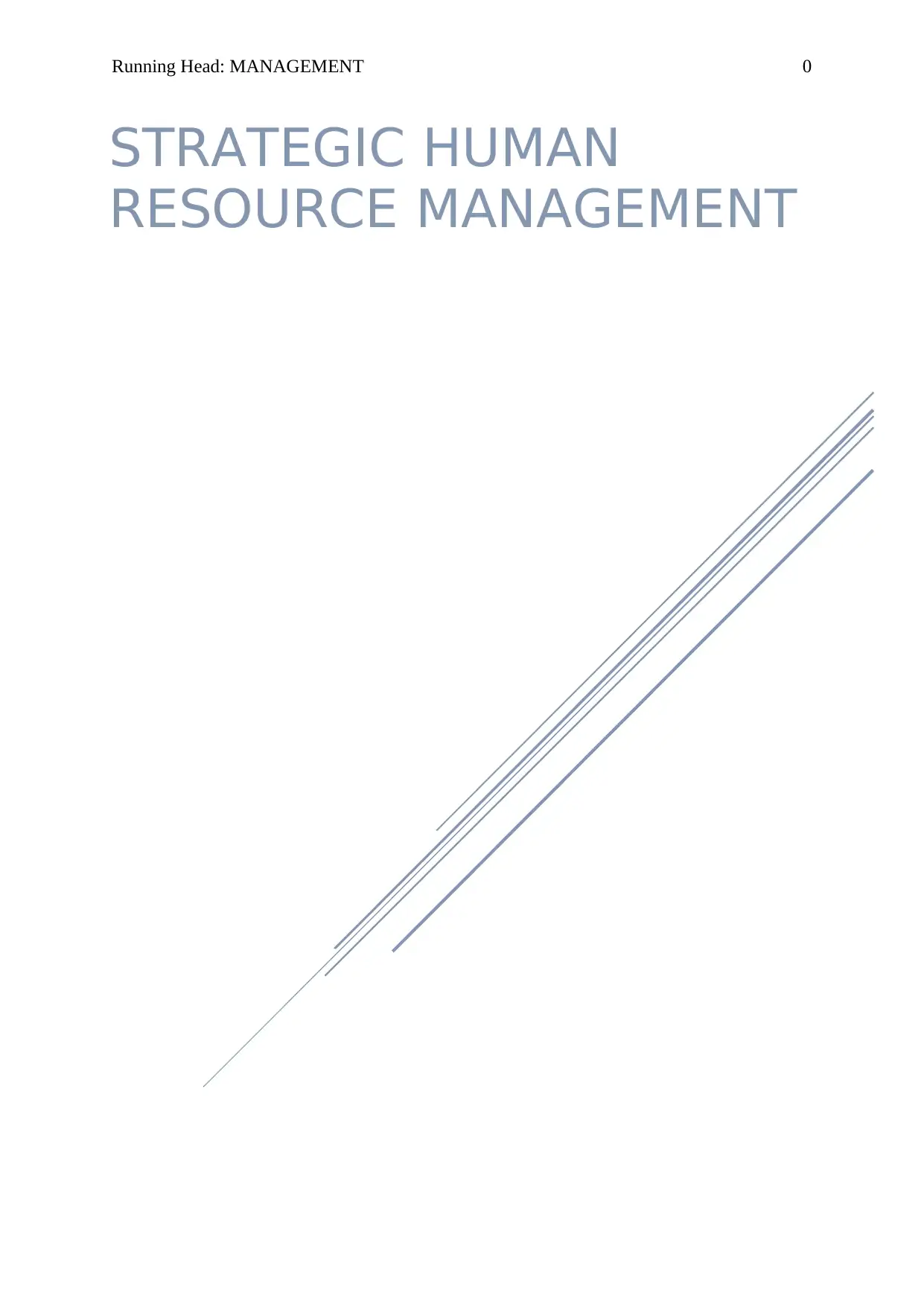
Running Head: MANAGEMENT 0
STRATEGIC HUMAN
RESOURCE MANAGEMENT
STRATEGIC HUMAN
RESOURCE MANAGEMENT
Paraphrase This Document
Need a fresh take? Get an instant paraphrase of this document with our AI Paraphraser

MANAGEMENT 1
Table of Contents
Strategic Human Resource Management...................................................................................2
Analyse the process of strategic human resource......................................................................3
Significance of HR management in Enterprises........................................................................4
SHRM Framework.....................................................................................................................5
Roles in strategic human resource management........................................................................5
HR Manager Job Responsibilities..........................................................................................5
Job Responsibilities of Human Resource Assistant...............................................................6
Job Responsibilities of Human Resource Director................................................................6
Job Responsibilities of HR Business Partner.........................................................................7
Development and Implementation of human resource strategies..............................................8
Range of HR strategies for an Enterprise...................................................................................8
Employee Performance Management....................................................................................9
Learning and Development of Employee..............................................................................9
Employee Reward Management............................................................................................9
Output and Quality Enhancement........................................................................................10
Controversy within SHRM......................................................................................................10
Contemporary issues affecting strategic human resource management..................................11
References 12
Table of Contents
Strategic Human Resource Management...................................................................................2
Analyse the process of strategic human resource......................................................................3
Significance of HR management in Enterprises........................................................................4
SHRM Framework.....................................................................................................................5
Roles in strategic human resource management........................................................................5
HR Manager Job Responsibilities..........................................................................................5
Job Responsibilities of Human Resource Assistant...............................................................6
Job Responsibilities of Human Resource Director................................................................6
Job Responsibilities of HR Business Partner.........................................................................7
Development and Implementation of human resource strategies..............................................8
Range of HR strategies for an Enterprise...................................................................................8
Employee Performance Management....................................................................................9
Learning and Development of Employee..............................................................................9
Employee Reward Management............................................................................................9
Output and Quality Enhancement........................................................................................10
Controversy within SHRM......................................................................................................10
Contemporary issues affecting strategic human resource management..................................11
References 12
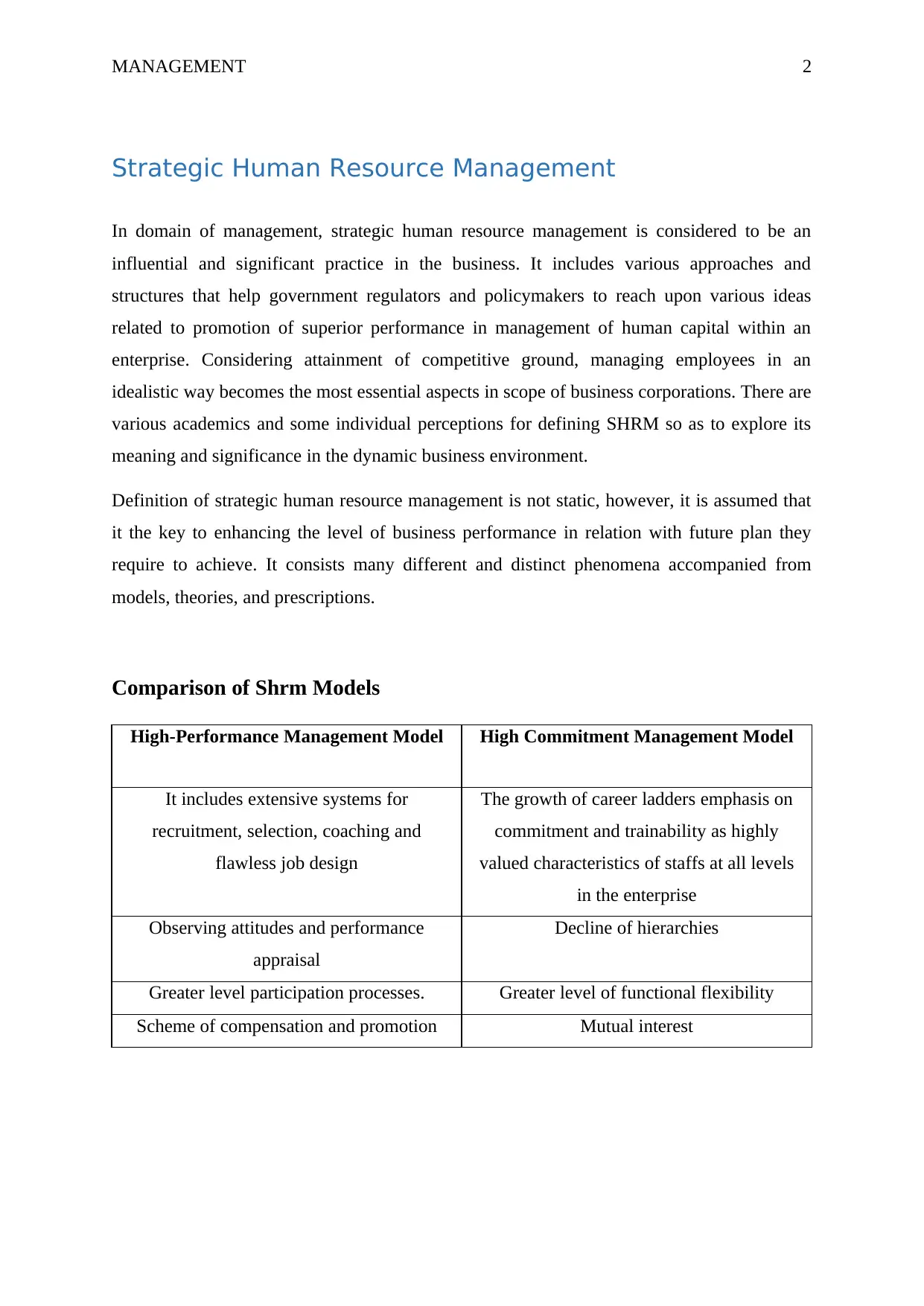
MANAGEMENT 2
Strategic Human Resource Management
In domain of management, strategic human resource management is considered to be an
influential and significant practice in the business. It includes various approaches and
structures that help government regulators and policymakers to reach upon various ideas
related to promotion of superior performance in management of human capital within an
enterprise. Considering attainment of competitive ground, managing employees in an
idealistic way becomes the most essential aspects in scope of business corporations. There are
various academics and some individual perceptions for defining SHRM so as to explore its
meaning and significance in the dynamic business environment.
Definition of strategic human resource management is not static, however, it is assumed that
it the key to enhancing the level of business performance in relation with future plan they
require to achieve. It consists many different and distinct phenomena accompanied from
models, theories, and prescriptions.
Comparison of Shrm Models
High-Performance Management Model High Commitment Management Model
It includes extensive systems for
recruitment, selection, coaching and
flawless job design
The growth of career ladders emphasis on
commitment and trainability as highly
valued characteristics of staffs at all levels
in the enterprise
Observing attitudes and performance
appraisal
Decline of hierarchies
Greater level participation processes. Greater level of functional flexibility
Scheme of compensation and promotion Mutual interest
Strategic Human Resource Management
In domain of management, strategic human resource management is considered to be an
influential and significant practice in the business. It includes various approaches and
structures that help government regulators and policymakers to reach upon various ideas
related to promotion of superior performance in management of human capital within an
enterprise. Considering attainment of competitive ground, managing employees in an
idealistic way becomes the most essential aspects in scope of business corporations. There are
various academics and some individual perceptions for defining SHRM so as to explore its
meaning and significance in the dynamic business environment.
Definition of strategic human resource management is not static, however, it is assumed that
it the key to enhancing the level of business performance in relation with future plan they
require to achieve. It consists many different and distinct phenomena accompanied from
models, theories, and prescriptions.
Comparison of Shrm Models
High-Performance Management Model High Commitment Management Model
It includes extensive systems for
recruitment, selection, coaching and
flawless job design
The growth of career ladders emphasis on
commitment and trainability as highly
valued characteristics of staffs at all levels
in the enterprise
Observing attitudes and performance
appraisal
Decline of hierarchies
Greater level participation processes. Greater level of functional flexibility
Scheme of compensation and promotion Mutual interest
⊘ This is a preview!⊘
Do you want full access?
Subscribe today to unlock all pages.

Trusted by 1+ million students worldwide

MANAGEMENT 3
Analyse the process of strategic human resource
With the help of Strategic human resource management, administration plan the components
of an HRM system to be consistent with one another in aligning with organisation objectives
and strategy. The aim of strategic HRM is the progress of an HRM system that enhance
business quality, efficiency, innovation and responsiveness to consumers. There are four
distinct stages involved in strategic human resource planning –
Environmental/Situation scanning and analysis
Anticipating demand for HR.
Examining the supply of HR.
Building of necessary plans to fill the gap amid HR demand and supply.
In first level, the key consideration is related with HR planning which includes interaction of
both themes i.e. strategic planning and HR. Environment assessment assist HR planners to
recognise and predict sources of opportunities and threats and put necessary efforts towards
progress of the enterprise strategic planning. It must ensure that strategic planning must
adjust with environmental situations and HR planning is considered to be a prime mechanism
that a business firm uses to attain this adaption process.
The second level, anticipating demand, needs forecasting not only how many but also what
sort of employees will be required in an enterprise. It must closely be linked to the strategic
direction of the enterprise. It causes difficulty for the manager due to rapid changing
environment. Some of forecasting technique contains estimation of individuals, projections
trend, unit-demand forecasting and statistical modelling.
The third level comprises examining the types and numbers of existing employees in relation
to training and abilities important for the upcoming time. Moreover, it involves supply of
qualified individuals in the external labour markets. To evaluate employees supply internally,
skills inventory is a major tool which consists list of individual name, skills and
characteristics presently working for the firm. Considering external labour market, the entire
nation may be relevant labour market for highly skilled jobs. On the other hand, the local
community will be the significant labour market for unskilful employments.
Analyse the process of strategic human resource
With the help of Strategic human resource management, administration plan the components
of an HRM system to be consistent with one another in aligning with organisation objectives
and strategy. The aim of strategic HRM is the progress of an HRM system that enhance
business quality, efficiency, innovation and responsiveness to consumers. There are four
distinct stages involved in strategic human resource planning –
Environmental/Situation scanning and analysis
Anticipating demand for HR.
Examining the supply of HR.
Building of necessary plans to fill the gap amid HR demand and supply.
In first level, the key consideration is related with HR planning which includes interaction of
both themes i.e. strategic planning and HR. Environment assessment assist HR planners to
recognise and predict sources of opportunities and threats and put necessary efforts towards
progress of the enterprise strategic planning. It must ensure that strategic planning must
adjust with environmental situations and HR planning is considered to be a prime mechanism
that a business firm uses to attain this adaption process.
The second level, anticipating demand, needs forecasting not only how many but also what
sort of employees will be required in an enterprise. It must closely be linked to the strategic
direction of the enterprise. It causes difficulty for the manager due to rapid changing
environment. Some of forecasting technique contains estimation of individuals, projections
trend, unit-demand forecasting and statistical modelling.
The third level comprises examining the types and numbers of existing employees in relation
to training and abilities important for the upcoming time. Moreover, it involves supply of
qualified individuals in the external labour markets. To evaluate employees supply internally,
skills inventory is a major tool which consists list of individual name, skills and
characteristics presently working for the firm. Considering external labour market, the entire
nation may be relevant labour market for highly skilled jobs. On the other hand, the local
community will be the significant labour market for unskilful employments.
Paraphrase This Document
Need a fresh take? Get an instant paraphrase of this document with our AI Paraphraser
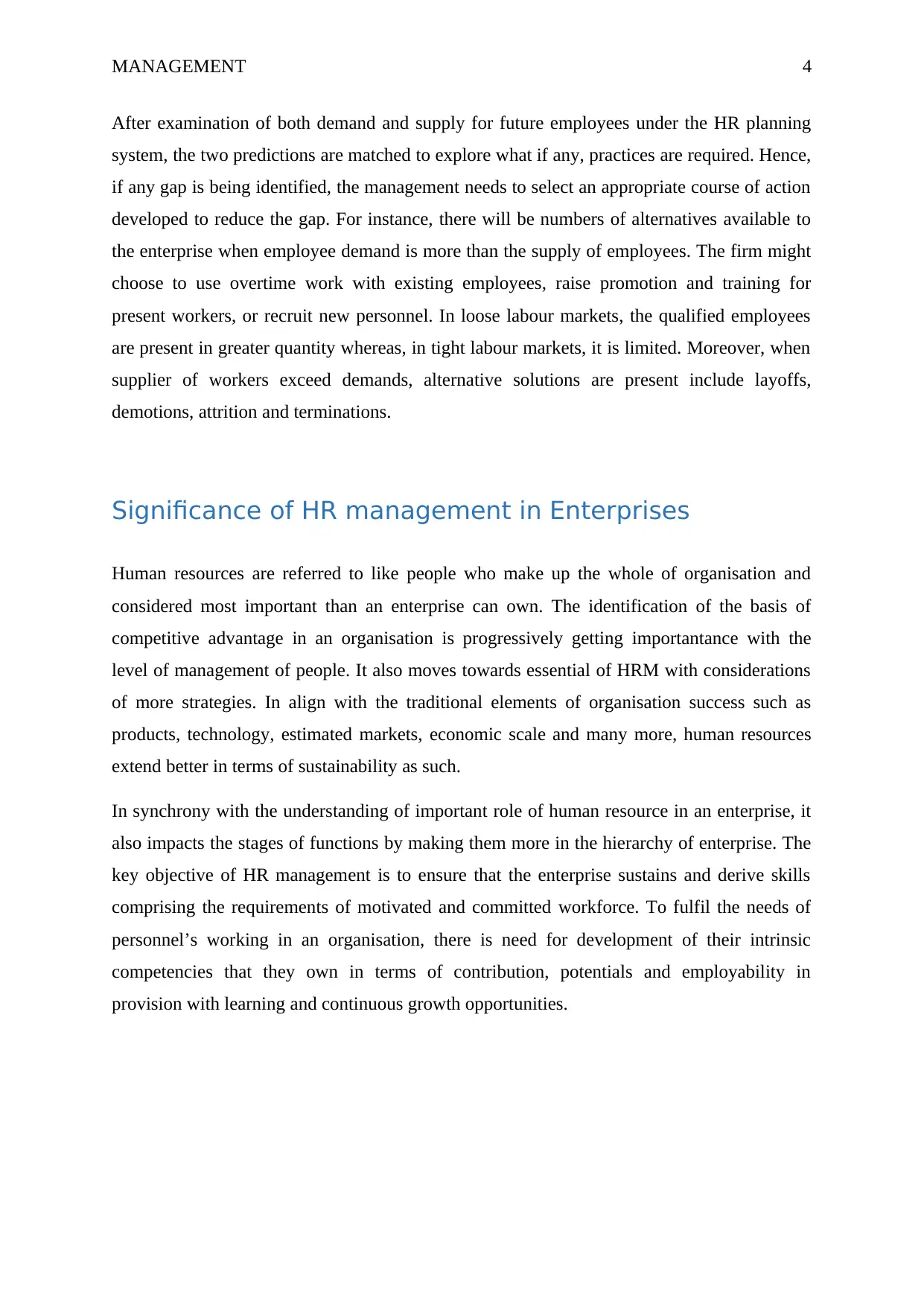
MANAGEMENT 4
After examination of both demand and supply for future employees under the HR planning
system, the two predictions are matched to explore what if any, practices are required. Hence,
if any gap is being identified, the management needs to select an appropriate course of action
developed to reduce the gap. For instance, there will be numbers of alternatives available to
the enterprise when employee demand is more than the supply of employees. The firm might
choose to use overtime work with existing employees, raise promotion and training for
present workers, or recruit new personnel. In loose labour markets, the qualified employees
are present in greater quantity whereas, in tight labour markets, it is limited. Moreover, when
supplier of workers exceed demands, alternative solutions are present include layoffs,
demotions, attrition and terminations.
Significance of HR management in Enterprises
Human resources are referred to like people who make up the whole of organisation and
considered most important than an enterprise can own. The identification of the basis of
competitive advantage in an organisation is progressively getting importantance with the
level of management of people. It also moves towards essential of HRM with considerations
of more strategies. In align with the traditional elements of organisation success such as
products, technology, estimated markets, economic scale and many more, human resources
extend better in terms of sustainability as such.
In synchrony with the understanding of important role of human resource in an enterprise, it
also impacts the stages of functions by making them more in the hierarchy of enterprise. The
key objective of HR management is to ensure that the enterprise sustains and derive skills
comprising the requirements of motivated and committed workforce. To fulfil the needs of
personnel’s working in an organisation, there is need for development of their intrinsic
competencies that they own in terms of contribution, potentials and employability in
provision with learning and continuous growth opportunities.
After examination of both demand and supply for future employees under the HR planning
system, the two predictions are matched to explore what if any, practices are required. Hence,
if any gap is being identified, the management needs to select an appropriate course of action
developed to reduce the gap. For instance, there will be numbers of alternatives available to
the enterprise when employee demand is more than the supply of employees. The firm might
choose to use overtime work with existing employees, raise promotion and training for
present workers, or recruit new personnel. In loose labour markets, the qualified employees
are present in greater quantity whereas, in tight labour markets, it is limited. Moreover, when
supplier of workers exceed demands, alternative solutions are present include layoffs,
demotions, attrition and terminations.
Significance of HR management in Enterprises
Human resources are referred to like people who make up the whole of organisation and
considered most important than an enterprise can own. The identification of the basis of
competitive advantage in an organisation is progressively getting importantance with the
level of management of people. It also moves towards essential of HRM with considerations
of more strategies. In align with the traditional elements of organisation success such as
products, technology, estimated markets, economic scale and many more, human resources
extend better in terms of sustainability as such.
In synchrony with the understanding of important role of human resource in an enterprise, it
also impacts the stages of functions by making them more in the hierarchy of enterprise. The
key objective of HR management is to ensure that the enterprise sustains and derive skills
comprising the requirements of motivated and committed workforce. To fulfil the needs of
personnel’s working in an organisation, there is need for development of their intrinsic
competencies that they own in terms of contribution, potentials and employability in
provision with learning and continuous growth opportunities.
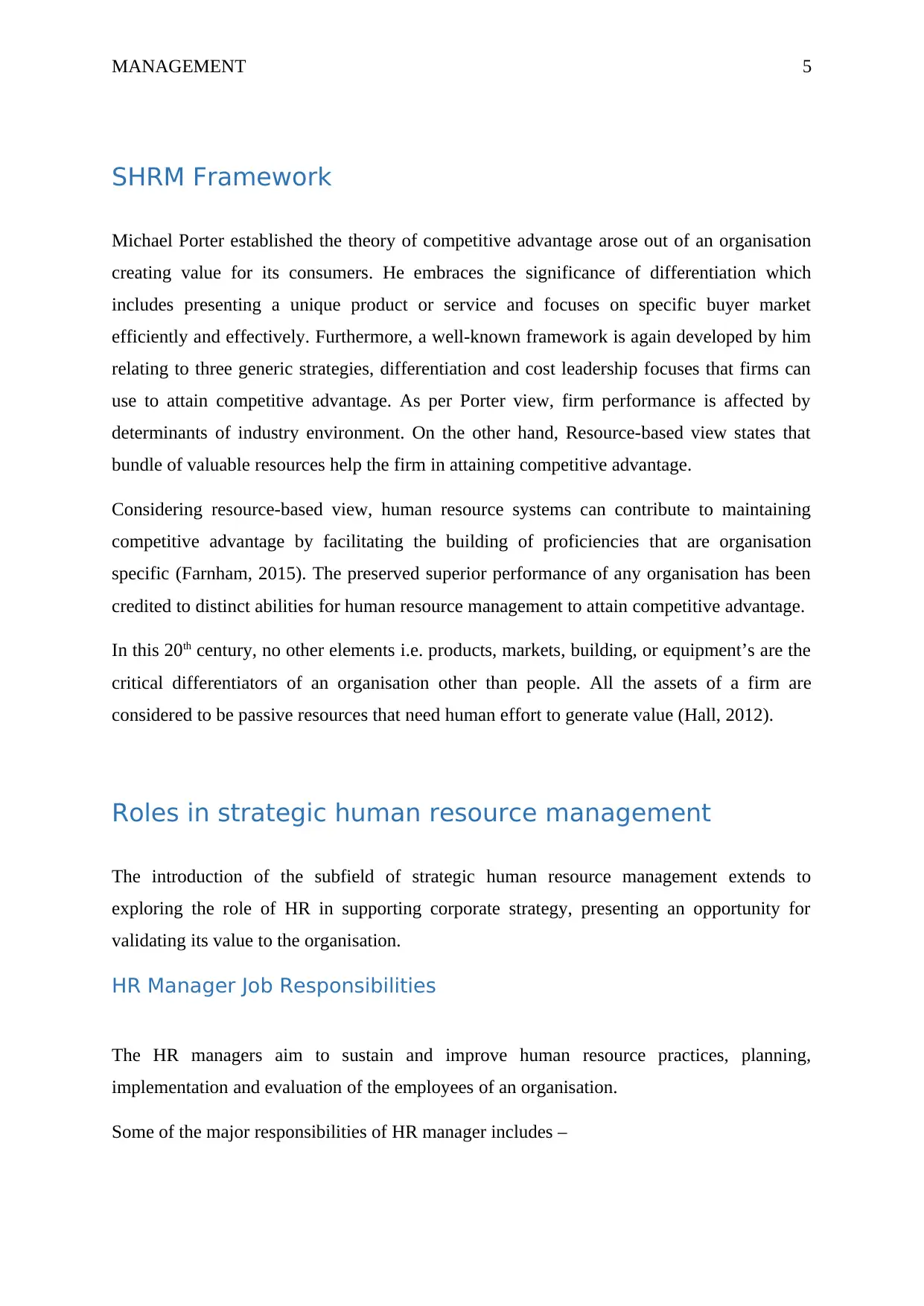
MANAGEMENT 5
SHRM Framework
Michael Porter established the theory of competitive advantage arose out of an organisation
creating value for its consumers. He embraces the significance of differentiation which
includes presenting a unique product or service and focuses on specific buyer market
efficiently and effectively. Furthermore, a well-known framework is again developed by him
relating to three generic strategies, differentiation and cost leadership focuses that firms can
use to attain competitive advantage. As per Porter view, firm performance is affected by
determinants of industry environment. On the other hand, Resource-based view states that
bundle of valuable resources help the firm in attaining competitive advantage.
Considering resource-based view, human resource systems can contribute to maintaining
competitive advantage by facilitating the building of proficiencies that are organisation
specific (Farnham, 2015). The preserved superior performance of any organisation has been
credited to distinct abilities for human resource management to attain competitive advantage.
In this 20th century, no other elements i.e. products, markets, building, or equipment’s are the
critical differentiators of an organisation other than people. All the assets of a firm are
considered to be passive resources that need human effort to generate value (Hall, 2012).
Roles in strategic human resource management
The introduction of the subfield of strategic human resource management extends to
exploring the role of HR in supporting corporate strategy, presenting an opportunity for
validating its value to the organisation.
HR Manager Job Responsibilities
The HR managers aim to sustain and improve human resource practices, planning,
implementation and evaluation of the employees of an organisation.
Some of the major responsibilities of HR manager includes –
SHRM Framework
Michael Porter established the theory of competitive advantage arose out of an organisation
creating value for its consumers. He embraces the significance of differentiation which
includes presenting a unique product or service and focuses on specific buyer market
efficiently and effectively. Furthermore, a well-known framework is again developed by him
relating to three generic strategies, differentiation and cost leadership focuses that firms can
use to attain competitive advantage. As per Porter view, firm performance is affected by
determinants of industry environment. On the other hand, Resource-based view states that
bundle of valuable resources help the firm in attaining competitive advantage.
Considering resource-based view, human resource systems can contribute to maintaining
competitive advantage by facilitating the building of proficiencies that are organisation
specific (Farnham, 2015). The preserved superior performance of any organisation has been
credited to distinct abilities for human resource management to attain competitive advantage.
In this 20th century, no other elements i.e. products, markets, building, or equipment’s are the
critical differentiators of an organisation other than people. All the assets of a firm are
considered to be passive resources that need human effort to generate value (Hall, 2012).
Roles in strategic human resource management
The introduction of the subfield of strategic human resource management extends to
exploring the role of HR in supporting corporate strategy, presenting an opportunity for
validating its value to the organisation.
HR Manager Job Responsibilities
The HR managers aim to sustain and improve human resource practices, planning,
implementation and evaluation of the employees of an organisation.
Some of the major responsibilities of HR manager includes –
⊘ This is a preview!⊘
Do you want full access?
Subscribe today to unlock all pages.

Trusted by 1+ million students worldwide

MANAGEMENT 6
Do timely updating of all job requirements and description considering work structure
management with all different position in organisation.
Do staff maintenance in organisation by establishing interview, recruitment and
testing mechanism of the enterprise.
Develop training and orientation programme for the assignment of employees.
All the programmes directed towards benefit of employees are managed by these HR
managers. Moreover, they also evaluate the needs of the developing trends in terms of
employee benefit.
Preparing, updating and recommending various practices related to maintaining
management regulations.
All historical records of HR and employees are managed by them for the purpose of
record keeping system.
Directing and controlling the behaviour of employees towards the job by effective
monitoring and planning.
Job Responsibilities of Human Resource Assistant
The main role of them is to assist the department of HR in terms of daily supervision under
various functions and duties. There are various different functional aspects in relation to HR
assistant responsibilities. These include employee relations, compensation, development of
departments, training and development.
Lado and Alonso (2017) identifies major responsibilities of this HR assistant such as –
Development of logistics for recruiting and staffing.
Monitoring the improvement in skills and supervising employee performance.
Improving and progressing relation amid employees by offering huge assistance.
Facilitate participation in the entire committee of enterprise.
Control effective communication within the organisation.
Support the routine operations of HR department for ensuring efficacy.
Job Responsibilities of Human Resource Director
Do timely updating of all job requirements and description considering work structure
management with all different position in organisation.
Do staff maintenance in organisation by establishing interview, recruitment and
testing mechanism of the enterprise.
Develop training and orientation programme for the assignment of employees.
All the programmes directed towards benefit of employees are managed by these HR
managers. Moreover, they also evaluate the needs of the developing trends in terms of
employee benefit.
Preparing, updating and recommending various practices related to maintaining
management regulations.
All historical records of HR and employees are managed by them for the purpose of
record keeping system.
Directing and controlling the behaviour of employees towards the job by effective
monitoring and planning.
Job Responsibilities of Human Resource Assistant
The main role of them is to assist the department of HR in terms of daily supervision under
various functions and duties. There are various different functional aspects in relation to HR
assistant responsibilities. These include employee relations, compensation, development of
departments, training and development.
Lado and Alonso (2017) identifies major responsibilities of this HR assistant such as –
Development of logistics for recruiting and staffing.
Monitoring the improvement in skills and supervising employee performance.
Improving and progressing relation amid employees by offering huge assistance.
Facilitate participation in the entire committee of enterprise.
Control effective communication within the organisation.
Support the routine operations of HR department for ensuring efficacy.
Job Responsibilities of Human Resource Director
Paraphrase This Document
Need a fresh take? Get an instant paraphrase of this document with our AI Paraphraser
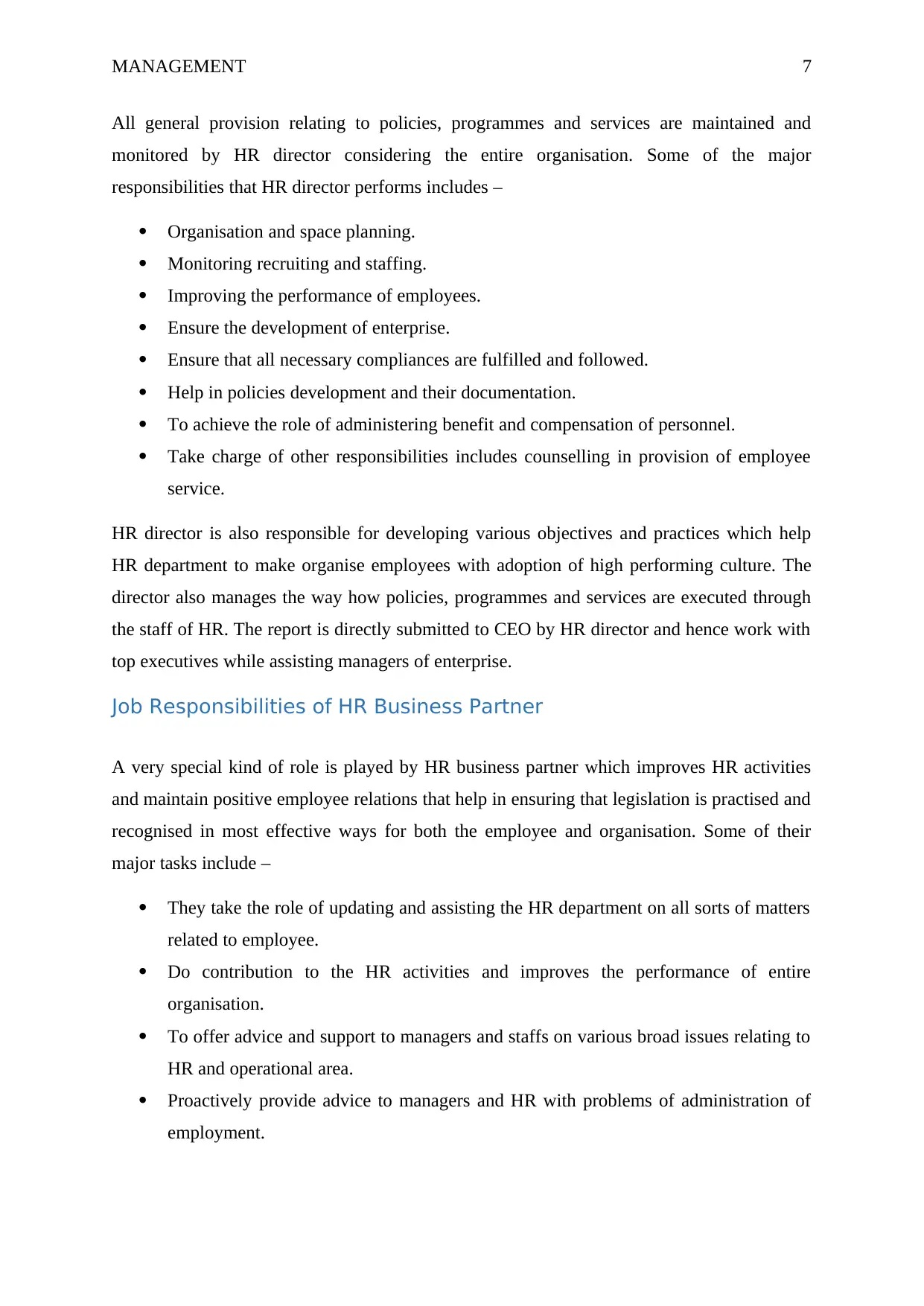
MANAGEMENT 7
All general provision relating to policies, programmes and services are maintained and
monitored by HR director considering the entire organisation. Some of the major
responsibilities that HR director performs includes –
Organisation and space planning.
Monitoring recruiting and staffing.
Improving the performance of employees.
Ensure the development of enterprise.
Ensure that all necessary compliances are fulfilled and followed.
Help in policies development and their documentation.
To achieve the role of administering benefit and compensation of personnel.
Take charge of other responsibilities includes counselling in provision of employee
service.
HR director is also responsible for developing various objectives and practices which help
HR department to make organise employees with adoption of high performing culture. The
director also manages the way how policies, programmes and services are executed through
the staff of HR. The report is directly submitted to CEO by HR director and hence work with
top executives while assisting managers of enterprise.
Job Responsibilities of HR Business Partner
A very special kind of role is played by HR business partner which improves HR activities
and maintain positive employee relations that help in ensuring that legislation is practised and
recognised in most effective ways for both the employee and organisation. Some of their
major tasks include –
They take the role of updating and assisting the HR department on all sorts of matters
related to employee.
Do contribution to the HR activities and improves the performance of entire
organisation.
To offer advice and support to managers and staffs on various broad issues relating to
HR and operational area.
Proactively provide advice to managers and HR with problems of administration of
employment.
All general provision relating to policies, programmes and services are maintained and
monitored by HR director considering the entire organisation. Some of the major
responsibilities that HR director performs includes –
Organisation and space planning.
Monitoring recruiting and staffing.
Improving the performance of employees.
Ensure the development of enterprise.
Ensure that all necessary compliances are fulfilled and followed.
Help in policies development and their documentation.
To achieve the role of administering benefit and compensation of personnel.
Take charge of other responsibilities includes counselling in provision of employee
service.
HR director is also responsible for developing various objectives and practices which help
HR department to make organise employees with adoption of high performing culture. The
director also manages the way how policies, programmes and services are executed through
the staff of HR. The report is directly submitted to CEO by HR director and hence work with
top executives while assisting managers of enterprise.
Job Responsibilities of HR Business Partner
A very special kind of role is played by HR business partner which improves HR activities
and maintain positive employee relations that help in ensuring that legislation is practised and
recognised in most effective ways for both the employee and organisation. Some of their
major tasks include –
They take the role of updating and assisting the HR department on all sorts of matters
related to employee.
Do contribution to the HR activities and improves the performance of entire
organisation.
To offer advice and support to managers and staffs on various broad issues relating to
HR and operational area.
Proactively provide advice to managers and HR with problems of administration of
employment.
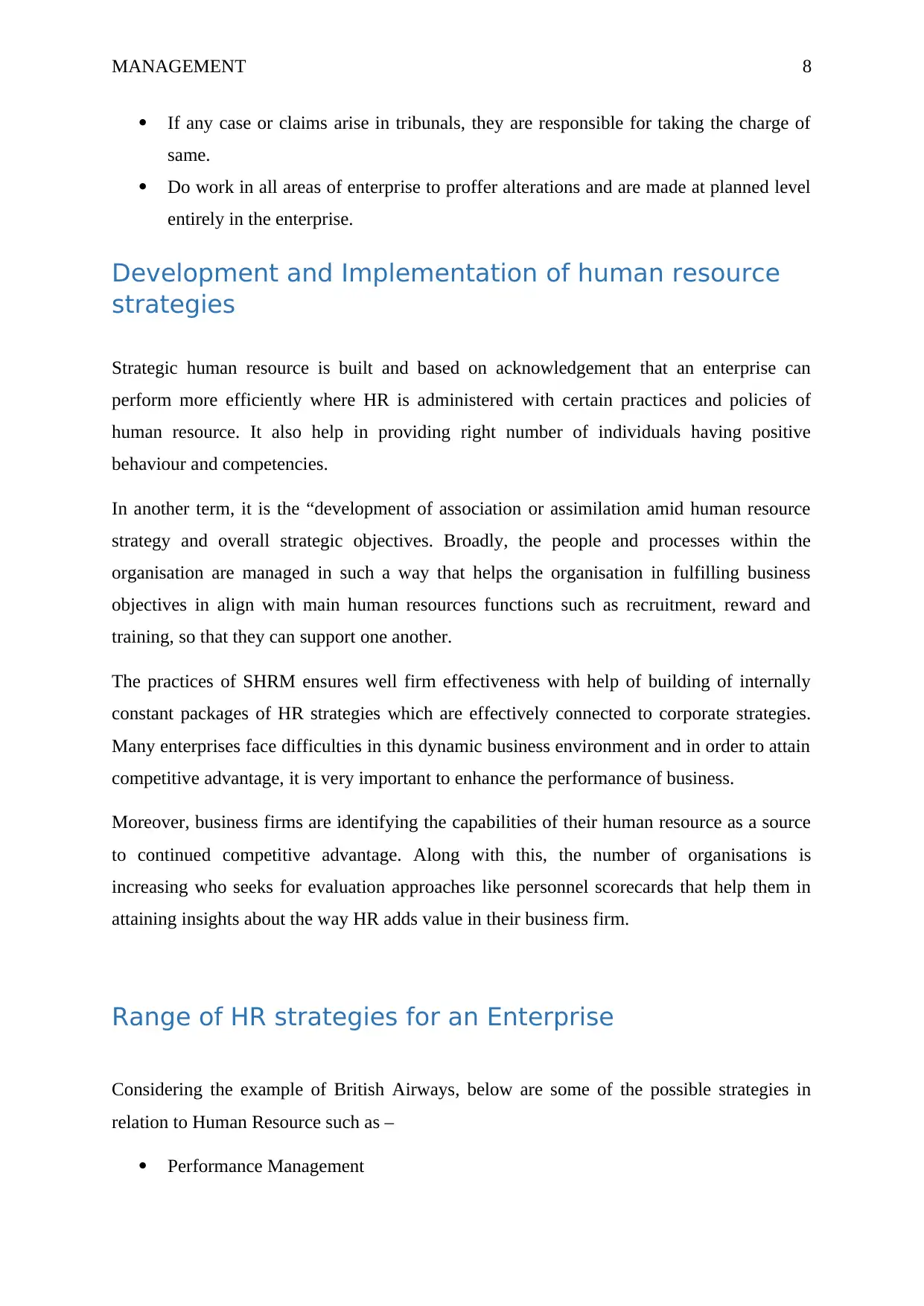
MANAGEMENT 8
If any case or claims arise in tribunals, they are responsible for taking the charge of
same.
Do work in all areas of enterprise to proffer alterations and are made at planned level
entirely in the enterprise.
Development and Implementation of human resource
strategies
Strategic human resource is built and based on acknowledgement that an enterprise can
perform more efficiently where HR is administered with certain practices and policies of
human resource. It also help in providing right number of individuals having positive
behaviour and competencies.
In another term, it is the “development of association or assimilation amid human resource
strategy and overall strategic objectives. Broadly, the people and processes within the
organisation are managed in such a way that helps the organisation in fulfilling business
objectives in align with main human resources functions such as recruitment, reward and
training, so that they can support one another.
The practices of SHRM ensures well firm effectiveness with help of building of internally
constant packages of HR strategies which are effectively connected to corporate strategies.
Many enterprises face difficulties in this dynamic business environment and in order to attain
competitive advantage, it is very important to enhance the performance of business.
Moreover, business firms are identifying the capabilities of their human resource as a source
to continued competitive advantage. Along with this, the number of organisations is
increasing who seeks for evaluation approaches like personnel scorecards that help them in
attaining insights about the way HR adds value in their business firm.
Range of HR strategies for an Enterprise
Considering the example of British Airways, below are some of the possible strategies in
relation to Human Resource such as –
Performance Management
If any case or claims arise in tribunals, they are responsible for taking the charge of
same.
Do work in all areas of enterprise to proffer alterations and are made at planned level
entirely in the enterprise.
Development and Implementation of human resource
strategies
Strategic human resource is built and based on acknowledgement that an enterprise can
perform more efficiently where HR is administered with certain practices and policies of
human resource. It also help in providing right number of individuals having positive
behaviour and competencies.
In another term, it is the “development of association or assimilation amid human resource
strategy and overall strategic objectives. Broadly, the people and processes within the
organisation are managed in such a way that helps the organisation in fulfilling business
objectives in align with main human resources functions such as recruitment, reward and
training, so that they can support one another.
The practices of SHRM ensures well firm effectiveness with help of building of internally
constant packages of HR strategies which are effectively connected to corporate strategies.
Many enterprises face difficulties in this dynamic business environment and in order to attain
competitive advantage, it is very important to enhance the performance of business.
Moreover, business firms are identifying the capabilities of their human resource as a source
to continued competitive advantage. Along with this, the number of organisations is
increasing who seeks for evaluation approaches like personnel scorecards that help them in
attaining insights about the way HR adds value in their business firm.
Range of HR strategies for an Enterprise
Considering the example of British Airways, below are some of the possible strategies in
relation to Human Resource such as –
Performance Management
⊘ This is a preview!⊘
Do you want full access?
Subscribe today to unlock all pages.

Trusted by 1+ million students worldwide
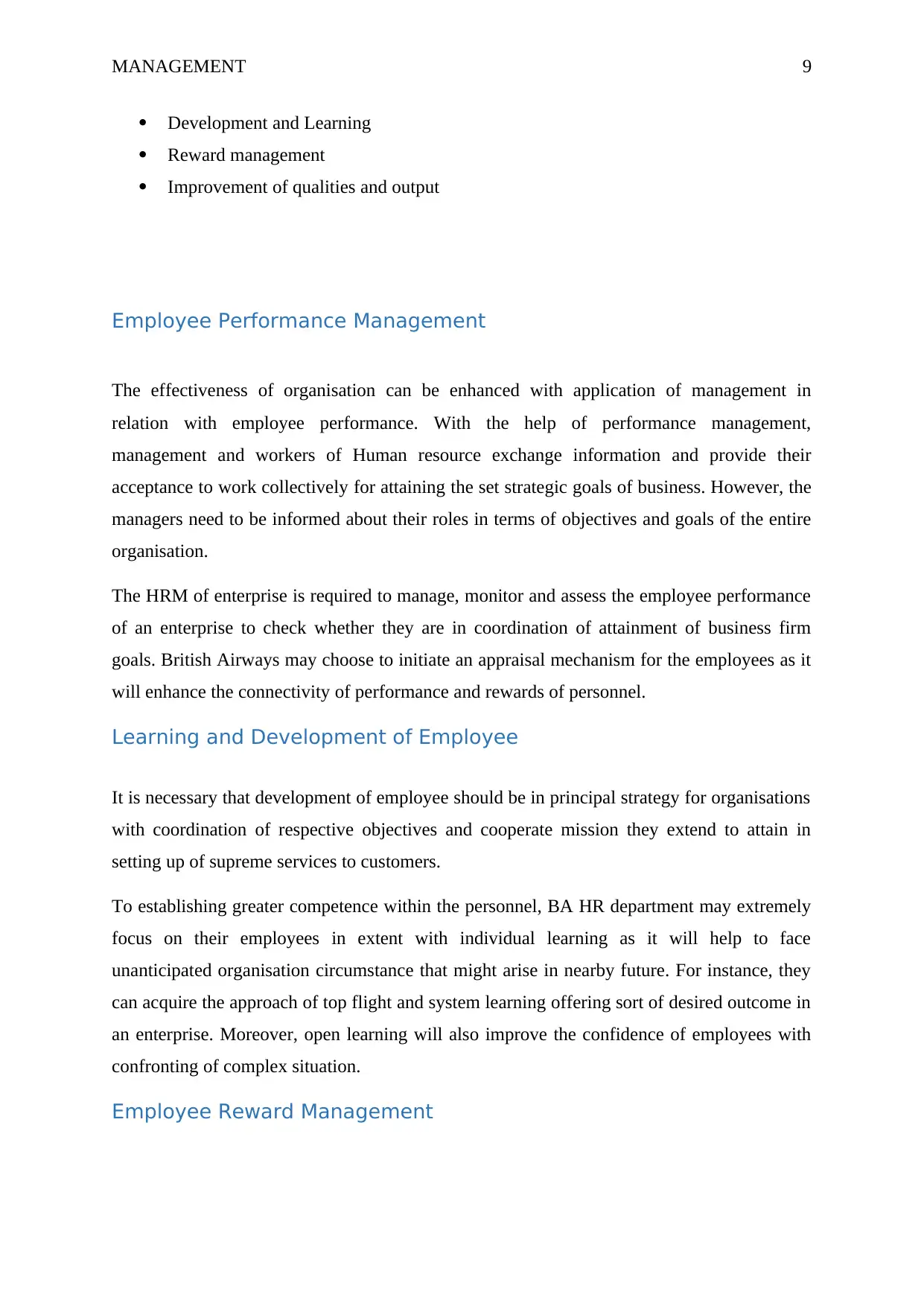
MANAGEMENT 9
Development and Learning
Reward management
Improvement of qualities and output
Employee Performance Management
The effectiveness of organisation can be enhanced with application of management in
relation with employee performance. With the help of performance management,
management and workers of Human resource exchange information and provide their
acceptance to work collectively for attaining the set strategic goals of business. However, the
managers need to be informed about their roles in terms of objectives and goals of the entire
organisation.
The HRM of enterprise is required to manage, monitor and assess the employee performance
of an enterprise to check whether they are in coordination of attainment of business firm
goals. British Airways may choose to initiate an appraisal mechanism for the employees as it
will enhance the connectivity of performance and rewards of personnel.
Learning and Development of Employee
It is necessary that development of employee should be in principal strategy for organisations
with coordination of respective objectives and cooperate mission they extend to attain in
setting up of supreme services to customers.
To establishing greater competence within the personnel, BA HR department may extremely
focus on their employees in extent with individual learning as it will help to face
unanticipated organisation circumstance that might arise in nearby future. For instance, they
can acquire the approach of top flight and system learning offering sort of desired outcome in
an enterprise. Moreover, open learning will also improve the confidence of employees with
confronting of complex situation.
Employee Reward Management
Development and Learning
Reward management
Improvement of qualities and output
Employee Performance Management
The effectiveness of organisation can be enhanced with application of management in
relation with employee performance. With the help of performance management,
management and workers of Human resource exchange information and provide their
acceptance to work collectively for attaining the set strategic goals of business. However, the
managers need to be informed about their roles in terms of objectives and goals of the entire
organisation.
The HRM of enterprise is required to manage, monitor and assess the employee performance
of an enterprise to check whether they are in coordination of attainment of business firm
goals. British Airways may choose to initiate an appraisal mechanism for the employees as it
will enhance the connectivity of performance and rewards of personnel.
Learning and Development of Employee
It is necessary that development of employee should be in principal strategy for organisations
with coordination of respective objectives and cooperate mission they extend to attain in
setting up of supreme services to customers.
To establishing greater competence within the personnel, BA HR department may extremely
focus on their employees in extent with individual learning as it will help to face
unanticipated organisation circumstance that might arise in nearby future. For instance, they
can acquire the approach of top flight and system learning offering sort of desired outcome in
an enterprise. Moreover, open learning will also improve the confidence of employees with
confronting of complex situation.
Employee Reward Management
Paraphrase This Document
Need a fresh take? Get an instant paraphrase of this document with our AI Paraphraser

MANAGEMENT 10
In this contemporary world, the use of the reward is one of the prime implemented methods
as system of payment. A reward can be perceived in both monetary and non-monetary form
but it just should signify that there is something special is being given for their achievement
and hard work. Some of the common reward payment systems include remuneration and
compensation. HR department should always be responsible towards development of
effective reward and payment system for all the personnel as it will add value to the strategic
plan of firm in line with development of goals that have been established.
Output and Quality Enhancement
The quality and output play a significant role in terms of organisational behaviour. Various
business enterprises are presently incorporating general management of the quality of their
strategies which recognises that all staff should take the responsibility of quality in terms of
their offering of products and services. BA should always embrace aggregated quality
management that will enhance the products and services they offer.
Controversy within SHRM
There is an interconnected relationship between employer and employee relations while
driving organisation achievement. The drive of BA for achievement of competence on the
persistent outsourcing and cost-cutting in which the organisation had to confront certain
disagreement with its employees that impact the enterprise image. BA had to face lot of
strikes but majorly of the motives and cost-cutting is linked with the modification of contract
of employment that led several issues with the society as passengers have to always confront
the strike when there is need for utmost travelling such as period of New Year celebration
and Christmas.
This segment is concerned with HR planning, staffing and selection that play another
significant role that BA have to go through as an outcome of the many changes that they have
to go through including strategic turnaround and privatisation occurred in 1997 and 1987
respectively. Later on, BA also merges with IBERIA which shows that staff management
goes global like it used to be in old ways.
In this contemporary world, the use of the reward is one of the prime implemented methods
as system of payment. A reward can be perceived in both monetary and non-monetary form
but it just should signify that there is something special is being given for their achievement
and hard work. Some of the common reward payment systems include remuneration and
compensation. HR department should always be responsible towards development of
effective reward and payment system for all the personnel as it will add value to the strategic
plan of firm in line with development of goals that have been established.
Output and Quality Enhancement
The quality and output play a significant role in terms of organisational behaviour. Various
business enterprises are presently incorporating general management of the quality of their
strategies which recognises that all staff should take the responsibility of quality in terms of
their offering of products and services. BA should always embrace aggregated quality
management that will enhance the products and services they offer.
Controversy within SHRM
There is an interconnected relationship between employer and employee relations while
driving organisation achievement. The drive of BA for achievement of competence on the
persistent outsourcing and cost-cutting in which the organisation had to confront certain
disagreement with its employees that impact the enterprise image. BA had to face lot of
strikes but majorly of the motives and cost-cutting is linked with the modification of contract
of employment that led several issues with the society as passengers have to always confront
the strike when there is need for utmost travelling such as period of New Year celebration
and Christmas.
This segment is concerned with HR planning, staffing and selection that play another
significant role that BA have to go through as an outcome of the many changes that they have
to go through including strategic turnaround and privatisation occurred in 1997 and 1987
respectively. Later on, BA also merges with IBERIA which shows that staff management
goes global like it used to be in old ways.
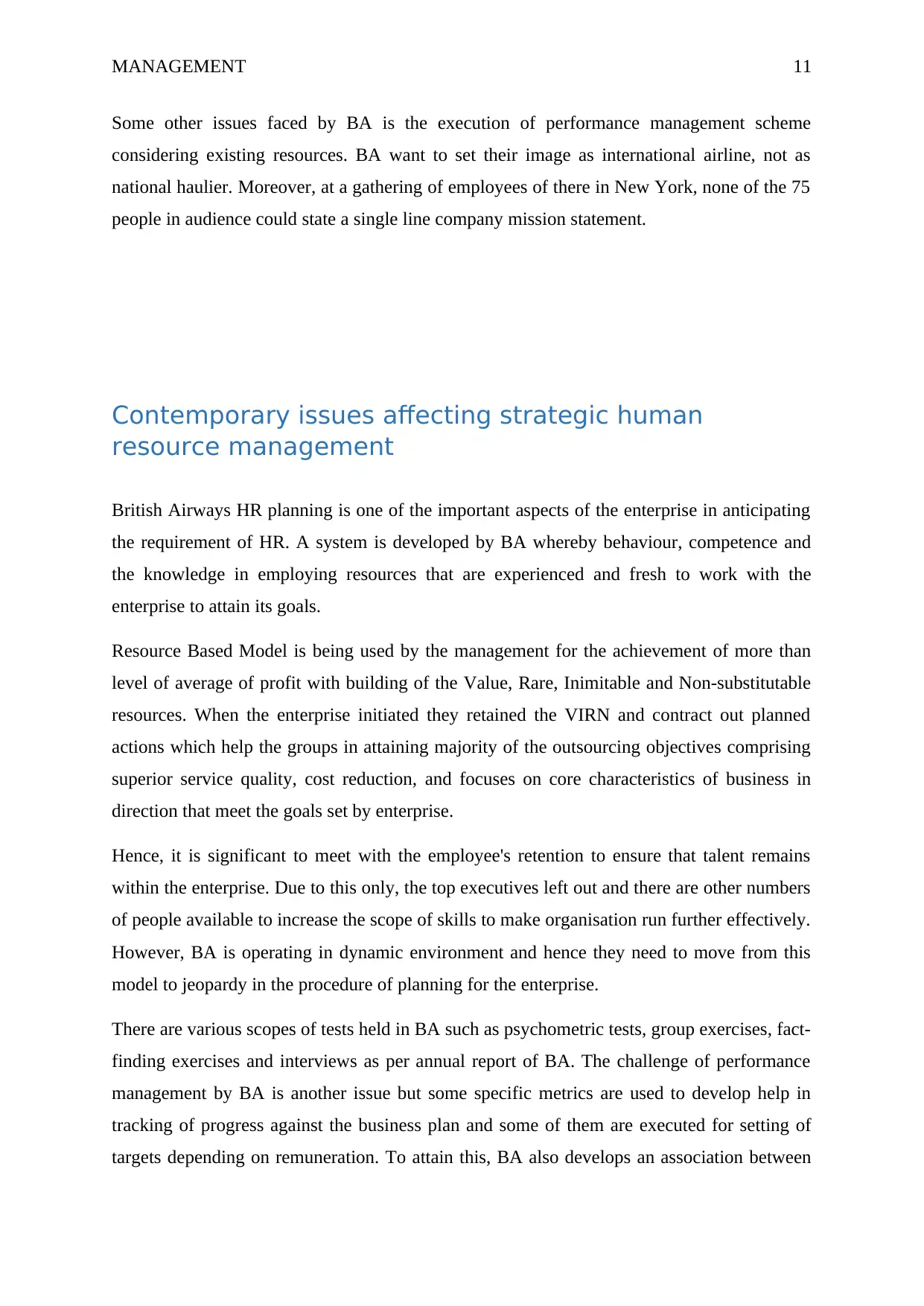
MANAGEMENT 11
Some other issues faced by BA is the execution of performance management scheme
considering existing resources. BA want to set their image as international airline, not as
national haulier. Moreover, at a gathering of employees of there in New York, none of the 75
people in audience could state a single line company mission statement.
Contemporary issues affecting strategic human
resource management
British Airways HR planning is one of the important aspects of the enterprise in anticipating
the requirement of HR. A system is developed by BA whereby behaviour, competence and
the knowledge in employing resources that are experienced and fresh to work with the
enterprise to attain its goals.
Resource Based Model is being used by the management for the achievement of more than
level of average of profit with building of the Value, Rare, Inimitable and Non-substitutable
resources. When the enterprise initiated they retained the VIRN and contract out planned
actions which help the groups in attaining majority of the outsourcing objectives comprising
superior service quality, cost reduction, and focuses on core characteristics of business in
direction that meet the goals set by enterprise.
Hence, it is significant to meet with the employee's retention to ensure that talent remains
within the enterprise. Due to this only, the top executives left out and there are other numbers
of people available to increase the scope of skills to make organisation run further effectively.
However, BA is operating in dynamic environment and hence they need to move from this
model to jeopardy in the procedure of planning for the enterprise.
There are various scopes of tests held in BA such as psychometric tests, group exercises, fact-
finding exercises and interviews as per annual report of BA. The challenge of performance
management by BA is another issue but some specific metrics are used to develop help in
tracking of progress against the business plan and some of them are executed for setting of
targets depending on remuneration. To attain this, BA also develops an association between
Some other issues faced by BA is the execution of performance management scheme
considering existing resources. BA want to set their image as international airline, not as
national haulier. Moreover, at a gathering of employees of there in New York, none of the 75
people in audience could state a single line company mission statement.
Contemporary issues affecting strategic human
resource management
British Airways HR planning is one of the important aspects of the enterprise in anticipating
the requirement of HR. A system is developed by BA whereby behaviour, competence and
the knowledge in employing resources that are experienced and fresh to work with the
enterprise to attain its goals.
Resource Based Model is being used by the management for the achievement of more than
level of average of profit with building of the Value, Rare, Inimitable and Non-substitutable
resources. When the enterprise initiated they retained the VIRN and contract out planned
actions which help the groups in attaining majority of the outsourcing objectives comprising
superior service quality, cost reduction, and focuses on core characteristics of business in
direction that meet the goals set by enterprise.
Hence, it is significant to meet with the employee's retention to ensure that talent remains
within the enterprise. Due to this only, the top executives left out and there are other numbers
of people available to increase the scope of skills to make organisation run further effectively.
However, BA is operating in dynamic environment and hence they need to move from this
model to jeopardy in the procedure of planning for the enterprise.
There are various scopes of tests held in BA such as psychometric tests, group exercises, fact-
finding exercises and interviews as per annual report of BA. The challenge of performance
management by BA is another issue but some specific metrics are used to develop help in
tracking of progress against the business plan and some of them are executed for setting of
targets depending on remuneration. To attain this, BA also develops an association between
⊘ This is a preview!⊘
Do you want full access?
Subscribe today to unlock all pages.

Trusted by 1+ million students worldwide
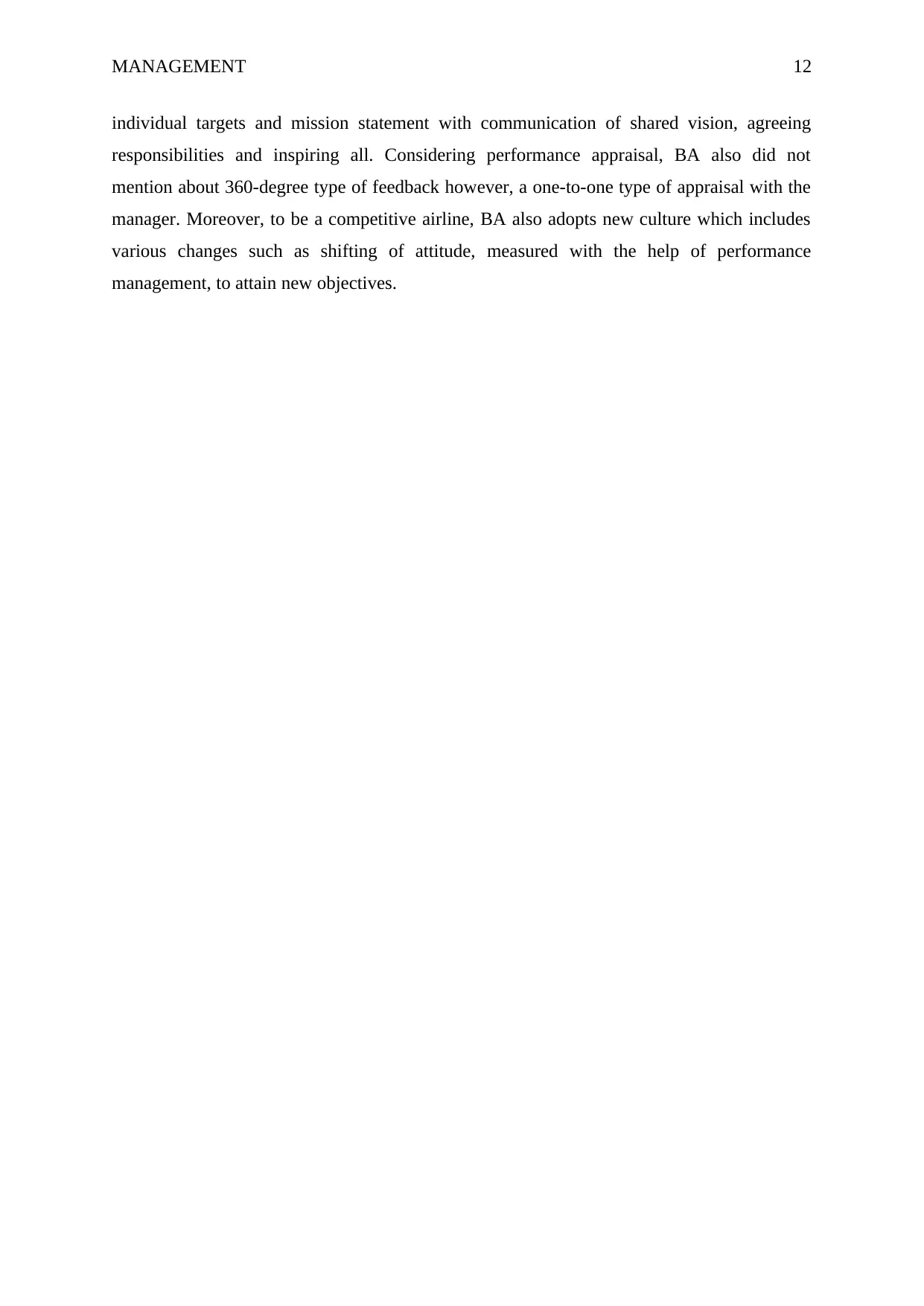
MANAGEMENT 12
individual targets and mission statement with communication of shared vision, agreeing
responsibilities and inspiring all. Considering performance appraisal, BA also did not
mention about 360-degree type of feedback however, a one-to-one type of appraisal with the
manager. Moreover, to be a competitive airline, BA also adopts new culture which includes
various changes such as shifting of attitude, measured with the help of performance
management, to attain new objectives.
individual targets and mission statement with communication of shared vision, agreeing
responsibilities and inspiring all. Considering performance appraisal, BA also did not
mention about 360-degree type of feedback however, a one-to-one type of appraisal with the
manager. Moreover, to be a competitive airline, BA also adopts new culture which includes
various changes such as shifting of attitude, measured with the help of performance
management, to attain new objectives.
Paraphrase This Document
Need a fresh take? Get an instant paraphrase of this document with our AI Paraphraser
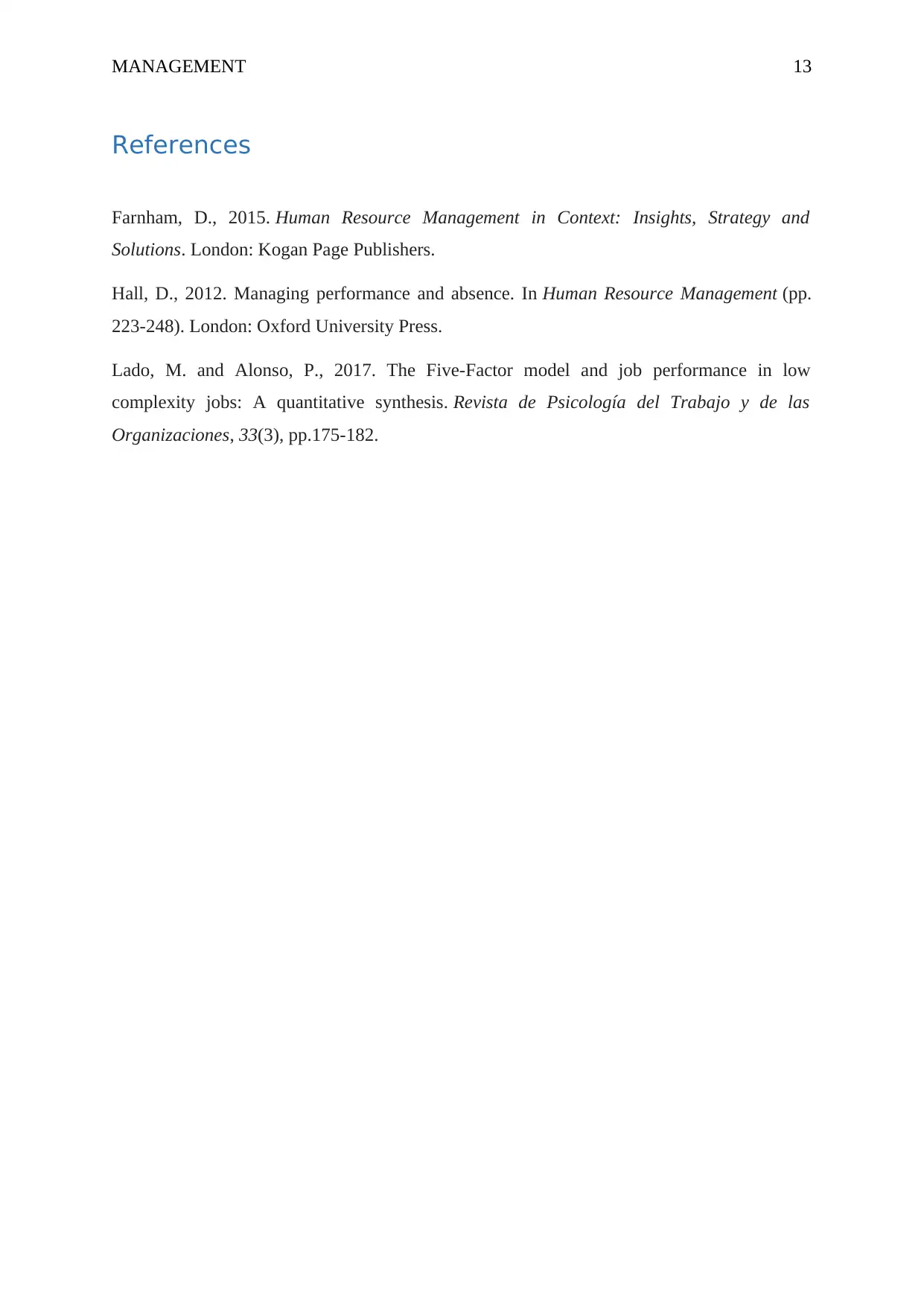
MANAGEMENT 13
References
Farnham, D., 2015. Human Resource Management in Context: Insights, Strategy and
Solutions. London: Kogan Page Publishers.
Hall, D., 2012. Managing performance and absence. In Human Resource Management (pp.
223-248). London: Oxford University Press.
Lado, M. and Alonso, P., 2017. The Five-Factor model and job performance in low
complexity jobs: A quantitative synthesis. Revista de Psicología del Trabajo y de las
Organizaciones, 33(3), pp.175-182.
References
Farnham, D., 2015. Human Resource Management in Context: Insights, Strategy and
Solutions. London: Kogan Page Publishers.
Hall, D., 2012. Managing performance and absence. In Human Resource Management (pp.
223-248). London: Oxford University Press.
Lado, M. and Alonso, P., 2017. The Five-Factor model and job performance in low
complexity jobs: A quantitative synthesis. Revista de Psicología del Trabajo y de las
Organizaciones, 33(3), pp.175-182.
1 out of 14
Related Documents
Your All-in-One AI-Powered Toolkit for Academic Success.
+13062052269
info@desklib.com
Available 24*7 on WhatsApp / Email
![[object Object]](/_next/static/media/star-bottom.7253800d.svg)
Unlock your academic potential
© 2024 | Zucol Services PVT LTD | All rights reserved.





